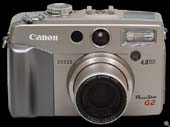 |
The digital camera
|
| With a normal camera, the image is captured on light- sensitive film. With a digital camera, the image is captured by an image sensor, and then stored in the camera on a memory device of some kind. The image is stored as a matrix of dots, each dot having a single colour. | |
| The quality of a printed image is measured in terms of its resolution – the number of dots per inch (dpi). A simple formula which relates the (linear) size (S) of an image to its resolution (R) is S
twice the size ? If we agree to change the resolution but then keep the print size the same by enlarging or reducing, the print quality may be noticeably affected. In the above example, do you expect the print quality to be improved or worsened by reducing the resolution? To check, slide the cursor over Check. It is fascinating to see how the camera cheats the eye in making discrete dot patterns appear continuous. For example, again sliding the cursor over the words, this ‘n’ appears as a clear, sharp white letter on a green background. But when enlarged it appears like this. |
|
 Now suppose we print out this image of a grevillea with resolution 144 dpi. If we change the resolution to 72 dpi, the new print image size is
Now suppose we print out this image of a grevillea with resolution 144 dpi. If we change the resolution to 72 dpi, the new print image size is